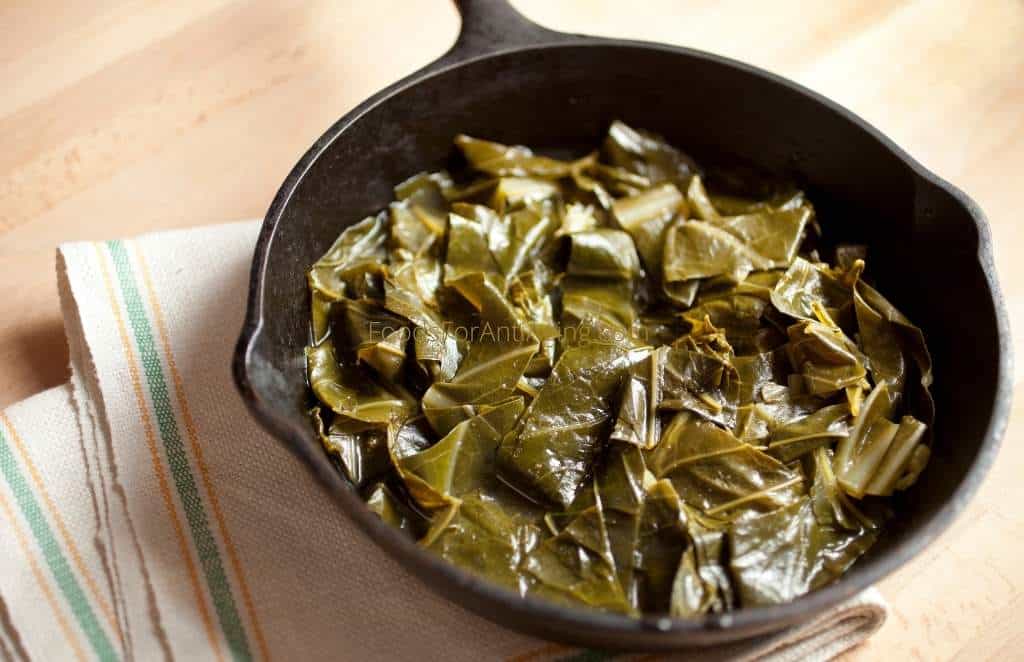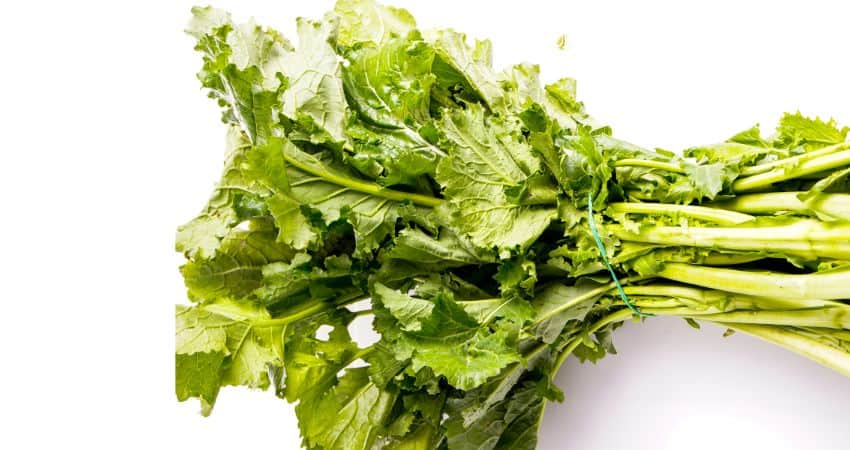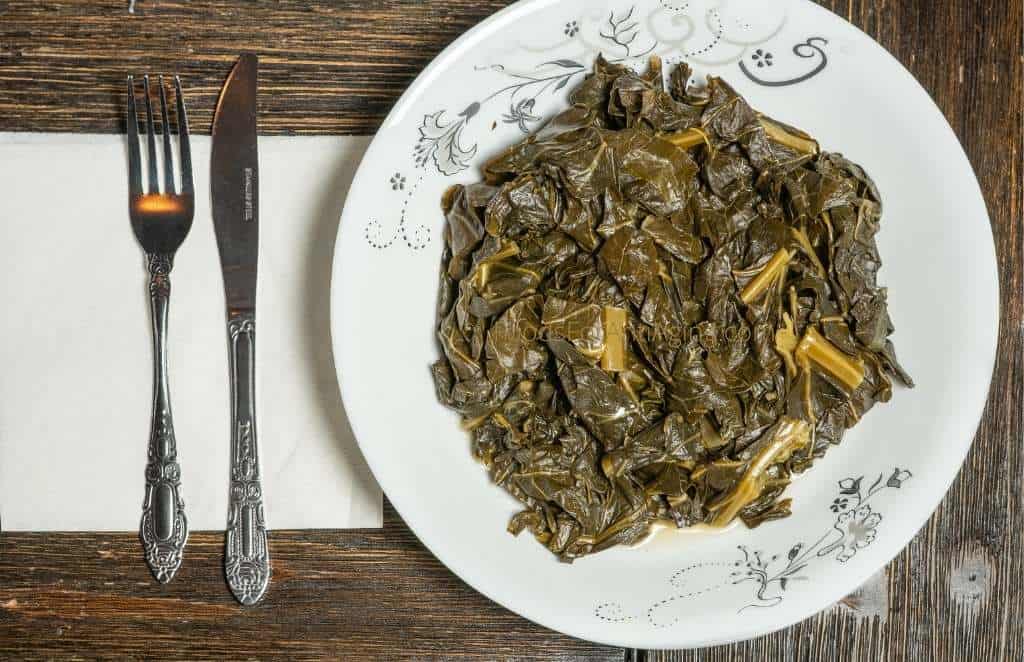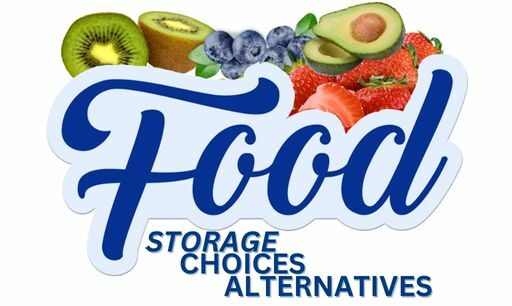Collard Greens Vs Turnip Greens: Which Is Better?
Collard greens and turnip greens are two of the most popular greens in the world. But there’s a big difference between them.
Collard greens have broad leaves which are dark green on top with lighter-green veins. Turnip greens have more slender leaves and are often reddish or white on top. Both are excellent sources of vitamins and minerals.
As a Certified Health Coach many people ask me about the two foods and their differences. I have researched and studied both of them to help clients. Now, in this article, I will explain everything about both greens.

Collard Greens Vs Turnip Greens: Is One More Nutritious Than The Other?
| Collard Greens (1 Cup Raw) | Turnip Greens (1 Cup Raw) | |
| Calories | 12 | 18 |
| Total Fat | 0.22 g | 0.17 g |
| Carbohydrates | 1.95 g | 3.92 g |
| Protein | 1.1 g | 0.82 g |
| Sugar | 0.17 g | 0.45 g |
| Fiber | 1.4 g | 1.8 g |
| Phosphorus | 9.00 mg | 23.10 mg |
| Calcium | 83.52 mg | 104.50 mg |
| Iron | 0.17 mg | 0.61 mg |
| Potassium | 76.68 mg | 162.80 mg |
| Magnesium | 9.72 mg | 17.05 mg |
| Zinc | 0.08 mg | 0.10 mg |
| Sodium | 6.12 mg | 22.00 mg |
| Vitamin D | 0.00 mcg | 0.00 mcg |
| Vitamin E | 0.81 mg | 1.57 mg |
| Vitamin K | 157.4 mcg | 138.1 mcg |
| Vitamin C | 12.7 mg | 33.0 mg |
| Vitamin A | 90.36 mcg | 318.45 mcg |
| B6 | 0.059 mg | 0.145 mg |
Collard greens and turnip greens are both good for you. They offer nutrients like calcium, magnesium, potassium, fiber and vitamins E, K, C, A and B61. Both have high water content and a low amount of calories2.
Why Turnip Greens Are Better Than Collard Greens
They both offer a large amount of nutrients, but which is better?
Turnip greens are better than collard greens because they contain more calcium, iron, potassium, magnesium, phosphorus, vitamin E, vitamin C, vitamin A and B6.
Let’s not underestimate collard greens3. They contain the same nutrients as turnip greens, just a little less. They contain less calories and carbohydrates for those interested in a low-carb diet. In addition, they contain a little more protein and vitamin K.
Both will offer excellent levels of vitamins and health benefits4, so the choice is yours as to which is better for your needs.

Turnip Greens and Collard Greens: Taste
Turnip greens and collard greens taste a little different. Collard greens are slightly bitter while turnip greens are sweeter. Turnip greens are softer than collard greens after cooked. Collard greens have more robust flavor.
Collards and turnips don’t necessarily taste different. Still, collard greens have a more robust flavor because they provide vitamin K. For those people who don’t eat meat or dairy products all the time may find this beneficial.
Turnip greens also cook up softer than collards and need to be eaten right away as too much seasoning will overpower their flavor.
Collard greens are slightly bitter while turnip greens seem sweeter.
Collard greens can be a bit strong for some people, but most find this bitterness is reduced when cooked. In salads, they are better because they do not overpower other flavors with bitterness like collards tend to.
One thing to keep in mind about collards is you can eat them in any dish where you would cook either collards or turnips. In addition, there are plenty of dishes where all three of these vegetables could be combined without sacrificing flavor.
My Home Taste Test
To conduct some original research on taste, I set up a taste test at my home to compare both foods.
Four of us were present and the taste test was a blind test. Both greens were prepared the same way. Three out of four people chose the turnip greens over the collard greens because they were sweeter.

What’s the best way to eat collard greens?
The best ways to eat collard greens are:
- Steam collard greens and eat them cold.
- Add them to your favorite pasta dishes or use them as a pizza topping.
- Cook and serve them over rice.
- For breakfast as a side for eggs.
- In collard green dolma, a rolled grape leaf stuffed with seasoned ground meat.
How do you eat turnip greens?
The best ways to eat turnip greens are:
- Saute turnip greens until wilted but still bright green. Season with salt, pepper, garlic powder, onion powder, basil, oregano and then drizzle on hot sauce. Serve atop linguini and top off with grated Parmesan cheese.
- Steam turnip greens or blanch them in boiling water before tossing with a squeeze of lemon juice, olive oil or Italian dressing. Serve as a side dish alongside your fish or chicken.
- Add fresh turnips to any salad for an interesting flavor twist.
Turnip Greens vs Collard Greens: Cost
Let’s face it, we’re not all made of money. Therefore, cost can be the determining factor when choosing which greens to purchase. Which costs more?
Collard greens and turnip greens cost the same price. The price varies depending on the location, packaging, fresh, frozen, organic or brand.
I searched the local supermarkets in my area and collected the prices of both. The following table below shows the prices of collard and turnip greens.
| Store | Fresh Collard Greens (Per Bunch) |
Fresh Turnip Greens (Per Bunch) |
| Walmart | 0.98 cents | 0.98 cents |
| Shoprite | 0.99 cents | 0.99 cents |
| Hannaford | $2.99 | $2.99 |
Disclaimer: Some links in this article are affiliate links which means I may earn a small commission at no extra cost to you. As an Amazon associate I earn from qualifying purchases.
Collard Vs Turnip Greens: Which Lasts Longer?
When choosing between the two, which one lasts longer might make your decision.
- Fresh turnip greens last for five to seven days before spoiling.
- You can keep collard greens in the refrigerator for five to seven days.
To make them both last the longest follow these steps:
- Don’t rinse the greens before storing.
- Place them into a food storage bag or keep them in an airtight container. Squeeze out the excess air.
- Refrigerate and place the bag or container in the crisper draw.
Both greens store in the same manner which simplifies things if you combine them together5.
Vacuum sealers are the best way to remove excess air from food storage bags. It’s one of those items which make you wonder how you did without it after purchasing one. Amazon has a nice variety at affordable prices. Check them out here, Vacuum Sealers.
How To Know When Collard and Turnip Greens Have Gone Bad
Collard greens have gone bad if:
- They turned soft.
- Wilting.
- Are slimy.
- Have a foul odor.
- Are discolored.
When turnip greens have turned bad check them for softness, wilting, discoloration, slim or a bad odor. If the greens exhibit any of these, discard them.
Freezing Turnip and Collard Greens
Collards and turnips should be unfrozen unless you cook them first. Freezing the greens will cause a loss in quality, taste and may result in spoiling. In addition, they won’t have the same consistency as when they are fresh.
How to freeze collard greens:
- Fill a large bowl with ice water.
- Bring a large pot of water to a boil.
- Rinse the collard greens.
- Add the greens to the boiling water for three minutes.
- Remove them from the boiling water and add them to the ice water for two minutes.
- Remove them from the ice water, drain and allow them to dry.
- Place them into a freezer bag and remove the excess air.
- Seal the bag and write the date on the bag.
- Store the bag in the deepest part of the freezer.
- The frozen collard greens will last in the freezer for 10-12 months.
How to freeze turnip greens:
- Fill a large bowl with ice water.
- Bring a large pot of water to a boil.
- Rinse the turnip greens.
- Add the greens to the boiling water for two minutes.
- Remove them from the boiling water and add them to the ice water for two minutes.
- Remove them from the ice water, drain and allow them to dry.
- Place them into a freezer bag and remove the excess air.
- Seal the bag and write the date on the bag.
- Store the bag in the deepest part of the freezer.
- The frozen turnip greens will last in the freezer for 8-12 months.
The main difference between the two is the extra minute of boiling the collards6. Don’t rinse the greens until they’re ready to be frozen7.
Collard Greens: The Basics
Collard greens are a type of cabbage that has been eaten for centuries, with evidence showing it was grown in ancient Rome and Greece over 2000 years ago. Collards have been part of the diet all over Europe, Africa and Asia8.
They are also one of the very few vegetables that provide vitamin K, which helps to promote bone health by aiding in blood clotting.
Consequently, they can be an essential dietary component for people who have been prescribed anticoagulant drugs or at risk of osteoporosis because they interfere with calcium absorption.
Always check with your physician prior to changing nutrition and/or when on medication.
While they are available year-round, peak collards season begins in early fall and lasts until the end of winter. At that time, they often go on sale to make room for other products more popular or can be stored longer without spoiling.
The collards plant grows up to three feet tall, and the leaves grow up to six inches long.
They are eaten in various ways, often cooked with vinegar and other seasonings or sautéed raw as baby collards or chips.
Turnip Greens: The Basics
Turnip greens are collard’s more slender cousin.
They come in purple, red or green shades and can have a slightly peppery taste with a turnip-like flavor to them. Turnip greens are often used in dishes like collard green dolma, turnip leaf tabbouleh or steamed turnips with a side of collards served up southern-style9.
Typically, you can find them during the early fall months through the springtime when they’re most plentiful and at their freshest. Their season starts earlier than collards because they grow more quickly, as they reach maturity after about 45 days, while collards 60 to 75 days (or even longer).
If you have any questions to ask me about this article don’t hesitate to comment below or email us. You can find an email on our contact page.
Read Next – More Food vs Food Articles!
Raspberries Vs Strawberries – Nutrition To Storage And More
Brown Rice vs White Rice: Which Is Better For Bodybuilding?
Strawberries Versus Blueberries – The Complete Comparison
Strawberries Vs Blueberries: Which is Healthier?
The 6 Best Vegetables To Go With Blueberries
- Nutritional Value: Collards, raw [↩]
- Nutritional Value: Turnip greens, raw [↩]
- National Center for Biotechnology Information: The effect of green leafy and cruciferous vegetable intake on the incidence of cardiovascular disease: A meta-analysis [↩]
- National Center for Biotechnology Information: Identification of the phenolic components of collard greens, kale, and Chinese broccoli [↩]
- Glad: Collard Greens [↩]
- University of Minnesota Extension: Freezing leafy greens for later use [↩]
- Michigan State University: Using, Storing and Preserving Greens [↩]
- Wikipedia: Collard [↩]
- Wikipedia: Turnip [↩]
